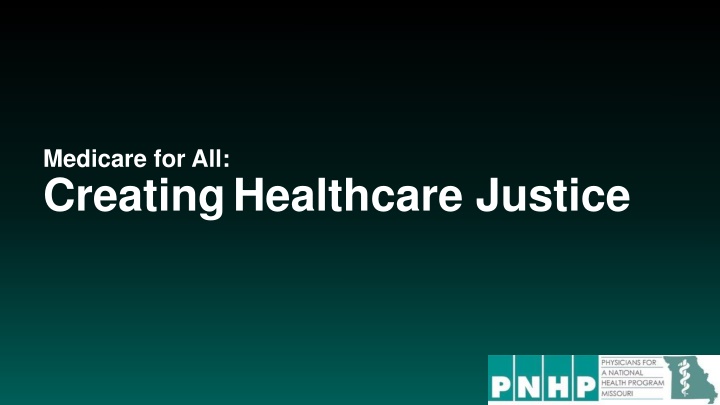
Healthcare Concerns and Inequality Impacting Americans
Americans express high levels of worry about healthcare issues, such as affordability and access. The fear of paying for serious illness, healthcare costs, and insurance disparities are prominent. Furthermore, there is a growing disparity in life expectancy based on income levels. Failure to expand Medicaid in North Carolina is shown to have detrimental effects on healthcare outcomes. These issues highlight the need for healthcare justice and reform in the United States.
Download Presentation

Please find below an Image/Link to download the presentation.
The content on the website is provided AS IS for your information and personal use only. It may not be sold, licensed, or shared on other websites without obtaining consent from the author. If you encounter any issues during the download, it is possible that the publisher has removed the file from their server.
You are allowed to download the files provided on this website for personal or commercial use, subject to the condition that they are used lawfully. All files are the property of their respective owners.
The content on the website is provided AS IS for your information and personal use only. It may not be sold, licensed, or shared on other websites without obtaining consent from the author.
E N D
Presentation Transcript
Medicare for All: CreatingHealthcare Justice
Americans Worry about Healthcare More Than about Other Issues Healthcare 55% Availability of guns 51% Social Security 44% Terrorism 40% Economy 34% Illegal immigration 34% 0% Percentage personally Worried a great deal 10% 20% 30% 40% 50% Gallup, March 1-8, 2018 http://news.gallup.com/poll/231533/concerns-healthcare-high-energy-unemployment- low.aspx?utm_source=alert&utm_medium=email&utm_content=morelink&utm_campaign=syndication Accessed March 31, 2018
40% of Americans Are Very Afraid of Paying for a Serious Illness 56% Fear Getting Seriously Ill 42% 40% 33% Fear Paying for Care if Seriously Ill 23% 23% All Americans (Extremely or very afraid) Have Not Experienced Financial Impact Have Experienced Financial Impact http://www.norc.org/PDFs/WHI%20Healthcare%20Costs%20Coverage%20and%20Policy/WHI%20Healthcare%20Cost s%20Coverage%20and%20Policy%20Issue%20Brief.pdf Accessed March 31, 2018
Growing Death Gap by Income Dramatic gains for the wealthy; losses for lower income 41.9 Remaining life expectancy at age 50 Rich: Poor Death Gap 1980: 4 years 36.2 32.3 2010: 13 years Richest 20% Poorest 20% 28.3 Turned 50 in 1980 Turned 50 in 2010 Growing Gap in Life Expectancy by Income National Academy of Sciences, 2015
Women Still Pay More for Insurance Individual Deductible Family Deductible Retiree Medical Remember The ACA outlawed gender-based rates. Industries with workforce >65% male $170 higher in female workforces $296 higher in female workforces 29% less common in female workforces Industries with workforce >65% female Male $557 Female $727 Male $1,318 Female $1,614 Male 27% Female 19% Deductible data for in-network care. Male industries typically manufacturing; female typically healthcare. https://www.mercer.us/our-thinking/healthcare/behind-in-pay-behind-in-benefits.html Accessed April 13, 2018
North Carolinas failure to expand Medicaid is Taking a Toll on NC s Health Uninsured who would have been insured Uninsured who would have been insured Individuals with depression Individuals with depression Diabetics using diabetes medicines Diabetics using diabetes medicines Women 50-64 with mamm in past 12 months Women 50-64 with mamm in past 12 months Women 21-64 with Pap Smear in pas 12 months Women 21-64 with Pap Smear in pas 12 months Individuals with catastrophic medical expenses Individuals with catastrophic medical expenses Number of avoidable deaths per year in NC Uninsured who would have been insured Uninsured who would have been insured Individuals with depression Individuals with depression Diabetics using diabetes medicines Diabetics using diabetes medicines Women 50-64 with mamm in past 12 months Women 50-64 with mamm in past 12 months Women 21-64 with Pap Smear in pas 12 months Uninsured who would have been insured Uninsured who would have been insured Individuals with depression Individuals with depression Diabetics using diabetes medicines Uninsured who would have been insured + 498,045 + 498,045 - 45,571 - 45,571 + 27,044 + 27,044 + 12,051 + 12,051 + 27,840 + 27,840 - 14,776 - 14,776 455 to 1,145 + 498,045 + 498,045 - 45,571 - 45,571 + 27,044 + 27,044 + 12,051 + 12,051 + 27,840 + 498,045 + 498,045 - 45,571 - 45,571 + 27,044 + 498,045 https://www.healthaffairs.org/do/10.1377/hblog20140130.036694/full/
Blacks Die Younger Than Whites Treatable, if you have access to healthcare Death gap is nearly six years. How? Violence Stroke 0.6 ys 0.5 ys Heart Disease 1.7 years Cancer 1.2 years Other 1.9 years 0 1 2 3 4 5 6 Life expectancy gap between Black and White Americans, Years http://www.cdc.gov/mmwr/preview/mmwrhtml/mm5036a2.htm accessed July 6 2014
More Than One Way to Treat Laryngeal Cancer 1.00 Odds of receiving radiation therapy as initial treatment among laryngeal cancer patients 0.78 White African American Adjusted for age, year, gender, and tumor characteristics Arch Otolaryng-Head and Neck Surg 2012;138:644
Racial Disparities Exist In Treatment for Many Diseases Rates of surgery for lung cancer1 Rates of cardiac cath after heart attack2 Rates of kidney transplantation3 Rates of joint replacement4 1NEJM, 1999,341:1231-1233 2NEJM;2001,344,1443-1449 3NEJM, 2000;;343:1537-1544 4NEJM;2000, 342:1043
Excess Post-MI Deaths in African Americans Largely Driven by Insurance Status 1.3 1.31 Relative Risk of Dying after Heart Attack 1.2 1.1 1.03 1.0 African Americans Adjusted for Insurance All Americans, Under-insured Ng K, Brotman D, Lau B, and Young J. JGIM 2012; 27:1368
Until age 65, Race Determines Your Type of Insurance Private 50% Public 37% None 13% Black Different and not equal Private 71% Public 20% None 9% White https://www.kff.org/report-section/key-facts-on-health-and-health-care-by-race-and-ethnicity-section-4-health-coverage/ 2014 data. Accessed Oct. 4, 2017
Until age 65, Insurance Depends on Race and Geography USA NC Uninsured, 2015 White Black 14% 12% 10% 8% https://www.kff.org/uninsured/state-indicator/rate-by-raceethnicity/?currentTimeframe=1&selectedDistributions=white-- black&sortModel=%7B%22colId%22:%22Location%22,%22sort%22:%22asc%22%7D
Remove differences in insurance and Racial Differences Nearly Disappear VA Dialysis Medicare Hospitals Blacks survive longer than whites Blacks survive longer than whites Death rates match across races Eliminate racial differences in insurance; Greatly reduce racial differences in survival. Dialysis: https://www.ncbi.nlm.nih.gov/pmc/articles/PMC2601720/ Accessed Sept 30 2017 VA: http://www.latimes.com/science/sciencenow/la-sci-sn-health-racial-disparities-va-20150922-story.html DOI: 10.1161/CIRCULATIONAHA.114.015124; Kovesdy, Norris, Boulware, et. al, Circulation, Sept 18, 2015 Medicare:Thielke, Stephen, et al. J Pers Med 2015;5(4):440-451 doi: 10.3390/jpm5040440 Accessed Oct. 4, 2017
Physicians for National Health Program Membership open to everybody not only to physicians! www.pnhp.org Facebook: DoctorsForSinglePayer Twitter: @pnhp
